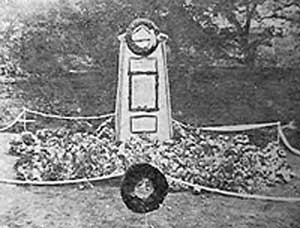|
On the last Saturday of August 1919 the people of Sabden held a ‘Victory, Peace Celebration Day’ with every resident taking part. From one end of Sabden to the other, roads, streets and houses were decked out with bunting, streamers and flags of the Allied Nations. The celebrations began at lunchtime with a procession through the village, consisting of eight decorated lorries, the heads of the various denominations, ex-servicemen, Sabden Brass Band, morris dancers, the scholars of both village schools all dressed in fancy costumes and followed by hundreds of Sabden residents. The procession ended on the cricket field with the rest of the afternoon spent dancing to the Sabden Brass Band and sporting events for all ages. Proceedings concluded in the evening with a torchlight procession around the village finishing with a grand firework display on the Holme. The main event of the day, however, had been the unveiling of a wooden cenotaph. The memorial was constructed by the Sabden branches of the Ambulance Society and Girl Guides. It was erected on the open space just below Brook Terrace (between where the post office and phone box stand today). The tablet on the front of the cenotaph bore the following inscription [the
names of forty men followed who They
died in war that we in peace might live,
|
The afternoon procession halted when it reached the cenotaph and stood
in silence facing the memorial. First the families of the fallen placed
wreaths around the foot of the memorial followed by the children of both
schools, each laying down a small posy of flowers.
The last post was then played as Sabden's demobilised soldiers
came forward and stood in line around the cenotaph. Why
Sabden never replaced the temporary memorial with a permanent one is at
present unknown, although at a council meeting on the 5th
April 1919 it was decided that a ‘Village Memorial Hall’ would be a
good idea and a committee was set up to look into this.
If
anybody has any further information I would be grateful if they could
pass it on to me. |
